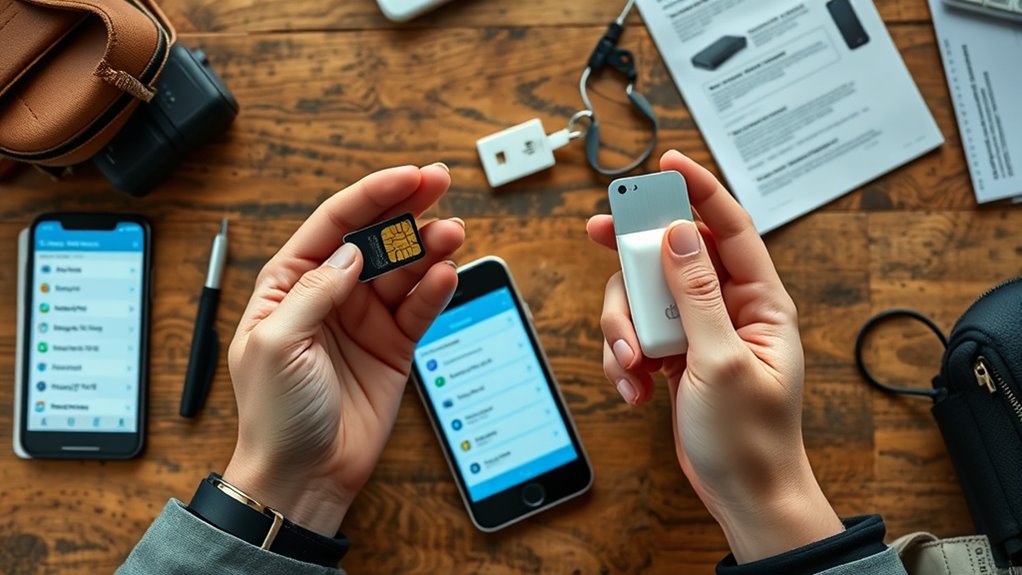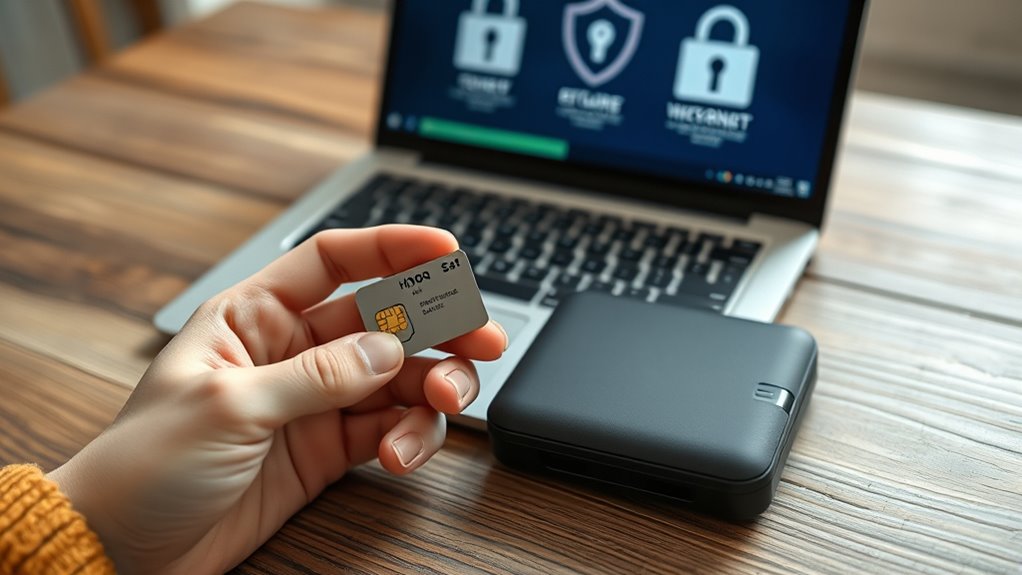Choosing between an international SIM card and a portable hotspot depends on your travel needs. SIM cards are more cost-effective for short trips and offer easy setup, but compatibility can sometimes be an issue. Hotspots provide reliable, multi-device coverage and better flexibility for longer stays, though they require a higher upfront investment. To find the best option abroad, consider coverage, plans, and security—more details will help you make the right choice for your trip.
Key Takeaways
- International SIM cards are cost-effective for short trips with minimal device needs, while hotspots suit longer stays and multiple devices.
- SIM cards offer quick, straightforward setup, whereas hotspots require powering on and Wi-Fi connection configuration.
- SIM cards depend on network coverage and may face compatibility issues; hotspots provide flexible device support via Wi-Fi.
- Cost and plan flexibility vary: SIM cards often include customizable plans; hotspots usually have limited plan options.
- Consider coverage, device compatibility, travel duration, and budget to determine the best option for internet abroad.
Cost Comparison Between International SIM Cards and Portable Hotspots

When comparing the costs of international SIM cards and portable hotspots, it’s important to take into account both upfront expenses and ongoing charges. International SIM cards often have lower initial costs but may incur additional fees for data plans or roaming. Portable hotspots usually require a higher upfront investment for the device, but their data plans can be more predictable. Keep in mind that device battery life impacts how long you can stay connected without recharging, influencing overall convenience. Customer support is also essential; some providers offer 24/7 assistance, which can save you time and frustration if issues arise. Additionally, understanding security vulnerabilities associated with new payment technologies can help you make safer choices when selecting devices and providers. Proper security measures can also mitigate risks related to wireless network security, which is crucial when using portable hotspots abroad. Being aware of network encryption standards can further enhance your safety while connected. It’s also worth considering how data management options can affect your overall costs and connectivity experience. Furthermore, evaluating the device compatibility with local networks can prevent connectivity issues during your travels. Ultimately, weighing upfront costs, ongoing expenses, device battery life, and support options helps you choose the most cost-effective solution for your needs abroad.
Ease of Use and Setup Procedures

Setting up an international SIM card is usually straightforward, especially if your phone supports multiple networks. Portable hotspots may require more steps, like powering on the device and connecting to Wi-Fi. You’ll also want to guarantee your device is compatible with the hotspot’s technology to avoid any connectivity issues. Additionally, understanding the setup procedures for each option can help ensure a smooth connection experience. Being aware of device compatibility can also prevent technical difficulties during setup. Remember that network coverage can vary depending on your location, so checking coverage maps in advance can help improve your experience. Moreover, considering the performance optimization of each method can ensure you get the most reliable internet connection when abroad. Proper configuration of your device settings can further enhance the stability and speed of your internet connection.
Setup Simplicity
Choosing between an international SIM card and a portable hotspot often comes down to setup ease. With a SIM card, you simply insert it into your unlocked phone, and you’re ready to go—no extra devices or complicated configurations. Portable hotspots, however, require turning on the device, charging it, and sometimes connecting multiple devices via Wi-Fi. Device durability and battery life play a role here: a durable hotspot with long battery life simplifies setup, especially if you’re traveling in rugged conditions or for extended periods. Using a SIM card involves minimal setup, making it the more straightforward choice if ease is your priority. In contrast, portable hotspots might need a bit more initial effort but offer flexibility once set up. Additionally, considering the ease of use and setup procedures can help determine which option best suits your travel needs. To further simplify your experience, opting for a device with long-lasting battery can reduce the need for frequent recharging during your trip. Moreover, understanding how device durability impacts reliability can ensure consistent internet access during your travels. Selecting a device with user-friendly setup features can also make the process even smoother. Investing in a device with simple activation steps can further streamline your connection process and save time.
Device Compatibility
Device compatibility substantially impacts how easy it is to use and set up an international SIM card or portable hotspot. If your device isn’t compatible, you’ll face device compatibility issues that delay connectivity and cause frustration. Ensuring your device supports the necessary networks and frequencies is vital. Some hotspots work universally, while others require specific hardware. Check your device’s specifications before choosing a solution. Consider this table for clarity:
| Device Type | Compatibility Notes | Common Issues |
|---|---|---|
| Smartphone | Often compatible with SIM cards | Network incompatibility |
| Tablet | Varies; check supported bands | Device lock or outdated hardware |
| Laptop with USB modem | Usually compatible with hotspots | Driver or software issues |
| Portable Hotspot | Many support multiple devices | Firmware or network setup issues |
| Older Devices | May lack support for newer tech | Compatibility issues might arise |
Coverage and Network Reliability in Different Regions

When it comes to coverage and network reliability, your experience can vary considerably depending on the region you’re in. In some areas, international SIM cards provide excellent network coverage and strong signal strength, guaranteeing you stay connected without issues. However, in remote or rural locations, signal strength may weaken, leading to slower data speeds or dropped connections. Portable hotspots often rely on local networks, which can offer better coverage in certain regions, especially where local providers have strong signals. Conversely, in regions with limited network infrastructure, hotspot devices might struggle to maintain reliable connections. Your choice between an international SIM card and a portable hotspot should consider the specific regions you’ll visit and their network infrastructure to ensure consistent, reliable internet access. Additionally, some devices may be better suited for different network standards to optimize connectivity in various areas. Moreover, understanding the coverage maps provided by service providers can help anticipate potential connectivity issues before traveling. Recognizing that Tesla vehicles depend on advanced network connectivity features can also impact your decision, especially if you plan to use vehicle-related services abroad. It is also beneficial to review network compatibility for your devices to avoid connectivity issues when traveling. It’s also important to recognize that some vintage devices may have compatibility issues with modern networks, which could impact your connectivity options.
Data Plans and Flexibility for Frequent Travelers

When choosing between an international SIM card or a portable hotspot, it’s important to think about your data plans and how flexible they are. Look for cost-effective options that fit your travel habits, and check if you can customize your plan as needed. Also, pay attention to usage limits and overage charges to avoid unexpected costs during your trips.
Cost-effective Data Options
For frequent travelers, choosing the right data plan can considerably impact overall costs and convenience. To maximize savings, explore various pricing strategies offered by providers, such as pay-as-you-go options, bulk packages, or unlimited plans. These options often vary in cost and coverage, so comparing them helps you find the most economical fit. Additionally, consider the quality of customer support, as reliable assistance can save you time and frustration if issues arise abroad. Many providers offer tiered plans tailored for heavy travelers, giving flexibility without breaking the bank. Be sure to check for hidden fees or restrictions that could inflate costs. Also, understanding local network compatibility can help you avoid connectivity issues and ensure smooth internet access during your trips. By weighing these factors carefully, you’ll ensure your data expenses stay manageable, keeping you connected without overspending.
Plan Customization Flexibility
Choosing the right data plan becomes even more important as a frequent traveler, especially when options vary widely in flexibility. With portable hotspots, plans are often fixed, but international SIM cards offer greater customization. You can select plans based on your travel frequency and data needs, and eSIM activation makes switching plans quick and easy. Plus, reliable customer support ensures help is available if issues arise. Flexibility lets you adjust your plan mid-trip or select specific data packages, saving money and avoiding overages. Here’s a comparison:
| Feature | International SIM Card | Portable Hotspot |
|---|---|---|
| Data plan customization | Yes | Limited |
| eSIM activation | Usually available | Not applicable |
| Flexibility during trips | High | Low |
| Customer support availability | Usually better | Varies |
| Plan adjustments | Easy and quick | Not always possible |
In addition, international SIM cards often include legal protections that can help resolve issues more effectively. Moreover, understanding network compatibility is crucial to ensure your device works seamlessly abroad. Staying informed about coverage areas can also prevent unexpected connectivity problems during your travels, especially since network coverage can vary significantly across regions. Being aware of regulatory policies in different countries can further enhance your experience and avoid potential legal complications.
Usage Limits and Overages
Since frequent travelers often need to manage data usage carefully, understanding the limits and potential overage charges of their plans is crucial. International SIM cards typically offer predefined data plans with specific usage limits, so exceeding them can lead to costly overage charges. Portable hotspots, on the other hand, may provide flexible data packages or pay-as-you-go options, giving you more control over your usage. However, some plans might have strict data caps, and overage charges can quickly add up if you go beyond your allotted data. To avoid surprises, always review your plan’s usage limits and overage policies beforehand. Being aware of these details helps you choose the right plan, keeping your internet costs predictable and preventing unexpected charges during your travels. Additionally, understanding software quality assurance metrics can help providers improve their service offerings and plan options over time. It’s also beneficial to consider data management strategies to optimize your internet use while abroad, especially when balancing usage limits and avoiding overage fees.
Device Compatibility and Compatibility Considerations

Device compatibility plays a vital role in determining whether an international SIM card or a portable hotspot is the right choice for you. Not all devices support international SIM cards, especially phones that are carrier-locked or lack the necessary SIM slot. Check if your device is unlocked and compatible with local networks abroad. Portable hotspots often have broader compatibility, working with any Wi-Fi-enabled device, but consider tethering options. Some hotspots may require specific firmware or frequency bands, so verify that your device can connect seamlessly. If you plan to share your internet connection with multiple devices, ensure your hotspot supports enough simultaneous connections. Ultimately, evaluating your device’s compatibility and tethering options guarantees you choose the most reliable and convenient solution for your travel needs.
Security and Privacy Aspects of Each Option

When considering the security and privacy aspects of international SIM cards and portable hotspots, it’s important to recognize how each option handles your data. International SIM cards often use encryption protocols to protect your calls and messages, but the level varies by provider. Data anonymization can also enhance privacy by removing identifiable information from your online activity, reducing tracking risks. Portable hotspots typically encrypt your data as it travels through their network, but the security depends on the hotspot’s features and the network it connects to. While both options offer basic security measures, neither guarantees complete privacy. You’ll need to be cautious about the networks you connect to and consider additional security tools to ensure your data remains protected abroad.
Practical Tips for Choosing the Best Internet Solution Abroad

Choosing the right internet solution abroad requires evaluating your specific needs, travel plans, and budget. Consider whether you prefer the convenience of a local SIM alternative or the flexibility of a portable hotspot. If your trip is short and you want ease, an international SIM card might be ideal. For longer stays or multiple devices, a portable hotspot could be better. Also, check if your travel insurance covers data issues or lost devices. Here’s a quick comparison:
| Factor | Recommendation |
|---|---|
| Duration of stay | Short trips: International SIM; Longer stays: Hotspot |
| Number of devices | Single device: Local SIM alternative; Multiple: Hotspot |
| Budget | Cost-effective plans: Local SIM options; All-in-one: Hotspot |
| Support & coverage | Travel insurance: Confirm coverage; Local SIM alternatives |
Assess these factors to choose the best fit for your travel needs.
Frequently Asked Questions
Can I Use an International SIM Card or Hotspot in Multiple Countries?
Yes, you can use an international SIM card or hotspot in multiple countries. Roaming agreements between your provider and local networks allow seamless data sharing across borders. Just guarantee your device supports the local frequencies, and be aware of potential additional charges. With an international SIM or portable hotspot, you stay connected effortlessly, avoiding the hassle of changing SIM cards or hunting for Wi-Fi, making your travel experience smoother and more convenient.
What Are the Hidden Costs Associated With Each Option?
You’ll want to watch out for hidden fees and overage charges with both options. International SIMs often surprise you with extra costs for roaming or exceeding data limits, while portable hotspots may have hidden fees for device rental or coverage fees. These sneaky charges can swiftly spike your expenses, so always read the fine print, compare plans, and clarify costs beforehand to avoid unexpected expenses during your travels.
How Does Battery Life Compare Between SIM Cards and Portable Hotspots?
You’ll find that portable hotspots generally have better battery efficiency and lower power consumption compared to SIM cards. Hotspots are designed to run longer on a single charge, often lasting all day with moderate use, while SIM cards depend on the device they’re in, which might drain power faster. If you need reliable, long-lasting internet on the go, a portable hotspot’s superior battery life makes it a smarter choice.
Are There Any Legal Restrictions on Using These Devices Abroad?
Yes, there are legal limitations and regulatory compliance issues when using international SIM cards or portable hotspots abroad. You need to check local laws, as some countries restrict or monitor the use of certain devices or SIM cards to prevent fraud or illegal activities. Always guarantee you’re complying with the regulations of the country you’re visiting, and verify if your device is approved for use to avoid potential fines or service disruptions.
Which Option Offers Better Support for Multiple Devices Simultaneously?
A portable hotspot generally offers better support for multiple devices simultaneously due to its device compatibility and network flexibility. You can connect several gadgets, such as smartphones, tablets, and laptops, all at once. An international SIM card typically limits the number of devices you can use, depending on the device compatibility and network restrictions. If you need to connect multiple devices easily, a portable hotspot is usually the more flexible and efficient choice.
Conclusion
Whether you prioritize cost, convenience, coverage, or security, both international SIM cards and portable hotspots offer unique benefits. Consider your travel style, data needs, and device compatibility to make the best choice. Weigh the ease of setup against network reliability, and flexibility against privacy concerns. Ultimately, your ideal internet solution should seamlessly connect you, protect your privacy, and suit your journey—because staying connected abroad should be simple, secure, and stress-free.








